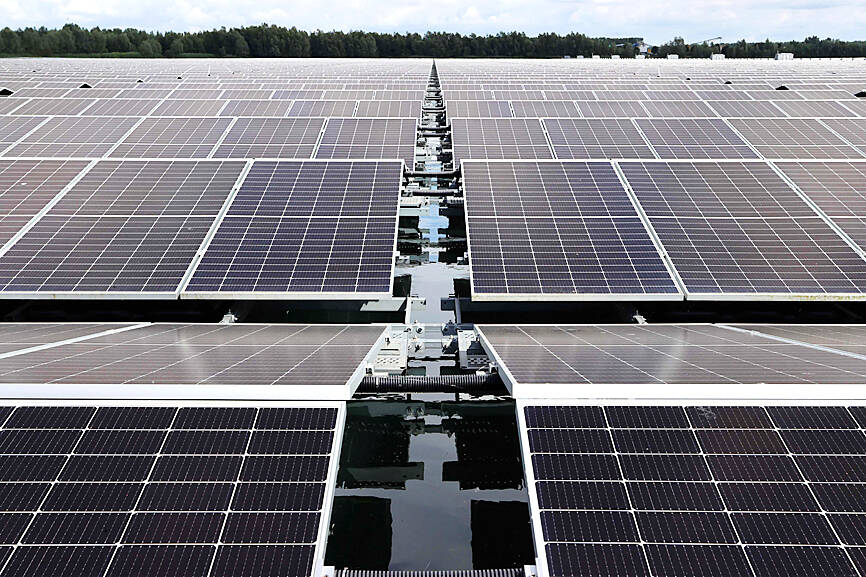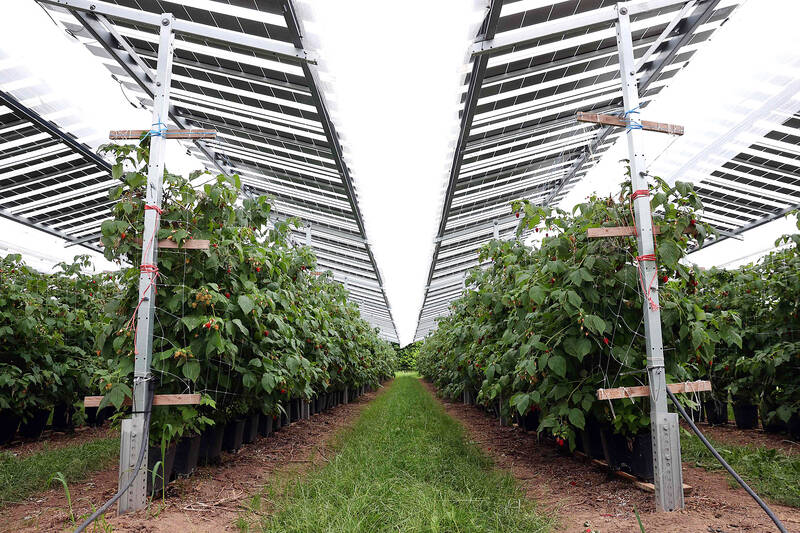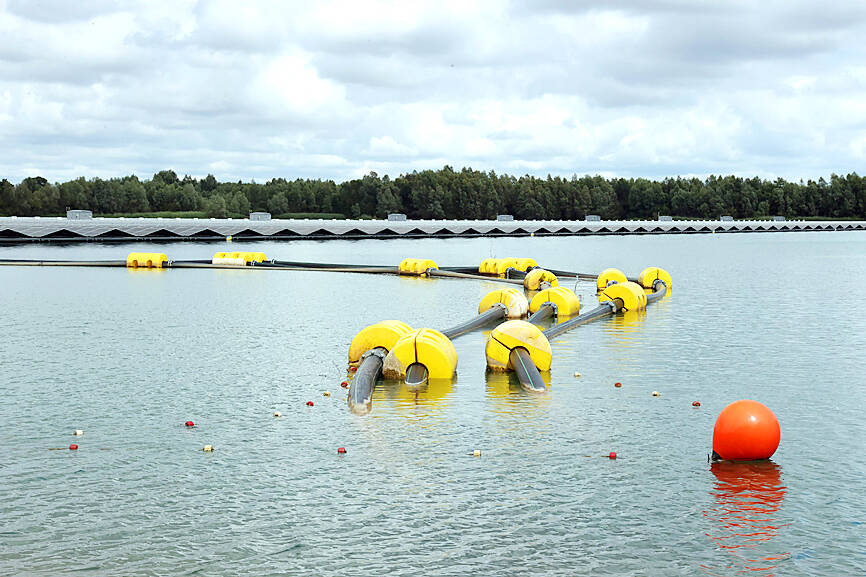In the Dutch countryside about 130km east of Amsterdam, an unusual-looking hill towers and glistens above farmhouses, leafless trees and muddy grassland.
The hill — 25m tall — is built from 15 years’ worth of household and business waste. What is remarkable is what is covering it — 23,000 solar panels.
Dutch solar developer TPSolar Nederland BV opened the array, which can produce up to 8.9 megawatts of power, in Armhoede, in the east of the Netherlands, in mid-2020. The former landfill now generates enough electricity for about 2,500 households.

Photo: AFP
The project reflects a wider drive in the Netherlands — which now has more than 48 million solar panels installed — to find innovative places to put new renewable energy capacity.
With land for renewable energy siting short nearly everywhere around the world, the Dutch experience — including putting solar on car parks, commercial lakes, sheep grazing fields, strawberry farms, disused churches, train stations and airfields — could inspire better siting of renewables globally.
“Because we have so little space in the Netherlands, it’s important to use the ground for multiple reasons,” said Bernd Nijen Twilhaar, a coordinator at Dutch solar developer Solarfields, which manages large solar farms and has installed at least 450,000 panels in the country.

Photo: AFP
“We have to be innovative and creative so we can produce the electricity the Netherlands needs to go green,” he added.
The Netherlands today has an average of two solar panels per inhabitant — and installed capacity of more than 1 kilowatt per person — making it Europe’s per-capita solar powerhouse, industry association SolarPower Europe said.
Solar developers and analysts say the expansion has been driven by a huge drop in equipment prices, an effective energy subsidy scheme and ambitious government targets to reduce greenhouse gas emissions.

Photo: AFP
The government aims to make 70 percent of its electricity renewable by 2030, mainly through expanding solar and wind power capacity as it seeks to cut its emissions as one of Europe’s top six polluting countries.
Like many EU nations, the Netherlands is cutting energy reliance on Russia following its invasion of Ukraine in February last year.
Dutch solar and wind farms have helped fill the electricity supply gap left by gas-fired power stations that have become unprofitable to run amid record-high gas prices.
However, the Netherlands’ farmland is among the most expensive in the EU, making finding space for solar plans costly.
That reality, combined with the country’s high population density, means solar firms have had to be inventive when it comes to finding space.
In the past few years, the Netherlands has enshrined climate targets such as its renewable energy goal into law, vowed to limit onshore gas and oil drilling, and boosted spending on renewable energy generally. The nation’s renewable energy budget last year was 13 billion euros (US$13.83 billion).
Last year, the Netherlands generated 14 percent of its electricity from solar farms — up from 1 percent in 2015 — overtaking coal-fired power generation for the first time.
The proportion of electricity from solar was the highest generated in the EU, consultancy group Ember Climate said.
In parallel, the country’s “net metering” system — set up in 2004 and which allows households with solar panels to offset their renewable electricity production against their consumption — has more than 2 million homes generating renewable power, the Dutch Ministry of Economic Affairs and Climate Policy said.
The Dutch government is assessing how site planning and financial support can be altered to encourage more construction of solar farms better integrated into the landscape, a ministry spokesman said by e-mail.
Joeri Jacobs, who focuses on building green energy projects as head of sustainable development at waste management company Afvalzorg, described the Dutch approach to renewables as “extremely MacGyver-ish” — referring to a 1980s US TV show about a resourceful secret agent who assembled ingenious devices from everyday objects.
“We take the different energy technologies, we stack them and we try to make a combination that really works,” said Jacobs, whose company has teamed up with a local utility to turn disused landfill sites into solar farms.
“It takes a while, but once everybody hops on the train we actually execute relatively quickly in the Netherlands,” he said.
Nearly 20 percent of the low-lying country’s surface is water, and solar power developers including GroenLeven BV have taken advantage by installing farms on man-made lakes.
The company has installed more than 500,000 solar panels on Dutch waters, leaving the Netherlands behind only China globally in such siting, it said.
“This idea of floating solar came up in the Netherlands earlier than in other countries,” said Benedikt Ortmann, global director of solar projects at German renewable energy company BayWa r.e. AG, which acquired GroenLeven in 2018.
Inspired by the Dutch example, BayWa r.e. said it is rolling out more floating solar sites in European countries such as Austria, Belgium and France.
Dutch firms are also looking for ways to make solar plants work alongside agricultural production.
“Rather than having to fight over who’s going to get the access to the land, we come up with solutions to jointly use it,” said Carel Kooij, business development manager for large-scale photovoltaic (PV) at the Dutch subsidiary of Swedish utility Vattenfall.
One so-called “Agri-PV” project involves growing strawberries and raspberries below a solar panel roof, replacing the plastic cover traditionally used by farmers.
Halfway through a four-year pilot, project leaders said the plants needed 25 percent less water because they were sheltered from the sun, potentially saving irrigation water in a future where climate change brings hotter and drier summers.
Across the board, Dutch solar developers say new projects must be conceived with local interests firmly in mind.
The country’s 2019 climate plan, for instance, stipulates that renewable energy projects should aim to allocate 50 percent of the green energy they produce to local inhabitants.
While this is not legally binding, developers tend to invest in the community — for example, from sending a percentage of renewable power generated to local energy cooperatives or setting up a socioeconomic fund to make energy efficiency improvements.
“Because the Netherlands is so small, you are always working in someone’s backyard,” TPSolar project developer Robert van der Horst said.
“You always have to talk to the people and discuss what is best for a certain area,” he added. “Then you try to enhance that with your solar farm.”

Intel Corp chief executive officer Lip-Bu Tan (陳立武) is expected to meet with Taiwanese suppliers next month in conjunction with the opening of the Computex Taipei trade show, supply chain sources said on Monday. The visit, the first for Tan to Taiwan since assuming his new post last month, would be aimed at enhancing Intel’s ties with suppliers in Taiwan as he attempts to help turn around the struggling US chipmaker, the sources said. Tan is to hold a banquet to celebrate Intel’s 40-year presence in Taiwan before Computex opens on May 20 and invite dozens of Taiwanese suppliers to exchange views

Application-specific integrated circuit designer Faraday Technology Corp (智原) yesterday said that although revenue this quarter would decline 30 percent from last quarter, it retained its full-year forecast of revenue growth of 100 percent. The company attributed the quarterly drop to a slowdown in customers’ production of chips using Faraday’s advanced packaging technology. The company is still confident about its revenue growth this year, given its strong “design-win” — or the projects it won to help customers design their chips, Faraday president Steve Wang (王國雍) told an online earnings conference. “The design-win this year is better than we expected. We believe we will win

Chizuko Kimura has become the first female sushi chef in the world to win a Michelin star, fulfilling a promise she made to her dying husband to continue his legacy. The 54-year-old Japanese chef regained the Michelin star her late husband, Shunei Kimura, won three years ago for their Sushi Shunei restaurant in Paris. For Shunei Kimura, the star was a dream come true. However, the joy was short-lived. He died from cancer just three months later in June 2022. He was 65. The following year, the restaurant in the heart of Montmartre lost its star rating. Chizuko Kimura insisted that the new star is still down

While China’s leaders use their economic and political might to fight US President Donald Trump’s trade war “to the end,” its army of social media soldiers are embarking on a more humorous campaign online. Trump’s tariff blitz has seen Washington and Beijing impose eye-watering duties on imports from the other, fanning a standoff between the economic superpowers that has sparked global recession fears and sent markets into a tailspin. Trump says his policy is a response to years of being “ripped off” by other countries and aims to bring manufacturing to the US, forcing companies to employ US workers. However, China’s online warriors